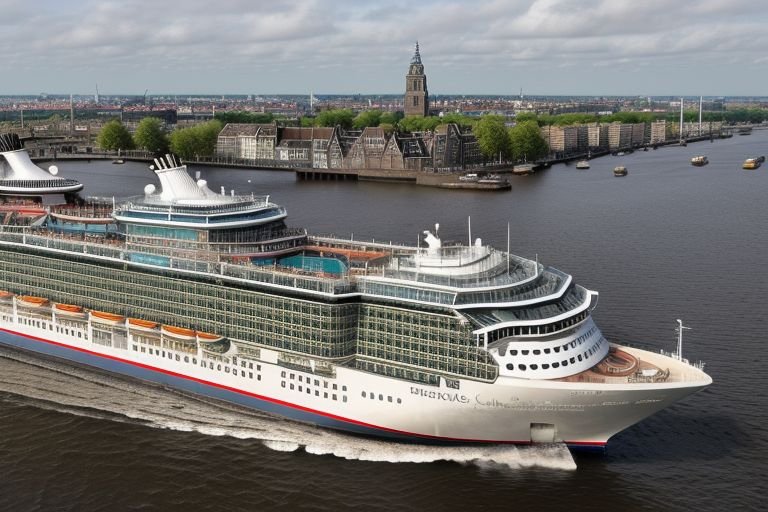
Amsterdam Bans Cruise Ships To Combat Overtourism And Pollution
Amsterdam has recently made a radical move to respond to the problems of excessive tourism and pollution – the Dutch city has restricted cruise ships in central Amsterdam. Amsterdam, a city whose beauty is evident from the biking paths and beautiful canal system, has long been struggling with the effects of over-tourism. This step change will signal a new form of politics within the city when it comes to strategies for managing tourist traffic and maintaining cultural heritage.
The rule that has come into force today also excludes large cruise ships from berthing at the central terminal close to Amsterdam’s central rail station. These vessels will thus be relocated to a new terminal, which will be created outside the central business district. This measure is a continuation of measures the government is taking to cut the number of day-trippers and the impact shallow-drafted cruise ships have on the ecosystem of the city.
Lately, Amsterdam’s Mayor, Femke Halsema, has called for changes to the tourism industry in her city. Hence in a statement she stressed that there is need to weigh up the economic gains of tourism to the corresponding impacts on the well-being of the people and on the amenity of amsterdam. The removal of cruise ships from the city center is regarded as the right action to establish this balance.
Cruise ships have always been problematic in Amsterdam. On the one hand, it is a major source of income. Each ship is estimated to generate €600 000 during its stay. On the other hand, it has effects such as overcrowding and pollution. This has gained much concern from environmentalists and residents along the coastal lines due to hazardous levels of air and water pollution in cruise ships.
The envisaged new policy is aimed at cutting down the quota of cruise ship tourists to Amsterdam, meaning an estimated 500,000 annually, as opposed to 800,000 at present. This has already been expected to have a noticeable effect on the traffic jams in areas frequented by tourists, such as the historic city center and the Red Light District.
Some local businesses have reacted positively to the ban, while others have not favored the ban at all. While there’s controversy as to whether it’s a good idea or a threat to their business that has pushed the government to act, there are many restaurant and shop owners who looked forward to the change for better and higher quality tourism. The city government also stated that it currently liaises with affected firms to assist them in managing their affairs under the new dispensation.
Critics have hailed the action as an appropriate move toward achieving the feat of eventually lowering Amsterdam’s emission levels and quality of air. The big cruise ships that used to berth in the city center were thought to be as damaging as thousands of cars. Amsterdam intends to drastically cut its emissions by moving these vessels to a terminal beyond its jurisdiction.
Cruise ship ban is but one of the measures that have been taken in order to try and control tourism in Amsterdam. Others are limiting Airbnb, hiking down tourist taxes, and early campaigns to make tourists check out regions they do not frequent, especially in the city and around it. These are measures in a bid to assist in the promotion of equitable distribution of tourism revenue effects and, at the same time, decrease congestion in the central business area.
Opponents of the ban have expressed their concern with the potential consequences of economic costs and advertisement damage to the tourist image of Amsterdam. However, officials who sit at the helm of these cities argue that any adverse economic impacts are overridden by the increase in sustainable tourism in the long run. They refer to measures adopted by such cities as Venice and Barcelona to curtail tourism as a sign that the practice of unsustainable urban tourism is on the increase.
What has needed to be changed is that the cruise ship ban has called for a lot of work in implementation. New terminal has adequate connections to the central city transport system to enable visitors to continue to explore the city’s attractions. Also, further to that, low impact, mini boats will also be permitted to ply their trade in the city center to accommodate for tourist interest in accessing the city through water.
While Amsterdam continues to react to this new policy, so do other cities in Europe. This is because the success and failure of this approach could define the future of tourism policies not only in other African countries that have embarked on aggressive tourism marketing campaigns but also those other tourist receiving countries that are equally facing the inevitable impacts of the sheer test of massive tourism.
The cruise ship ban also poses a new kind of challenge to Amsterdam’s tourism and urban community management. Taking into account the leaders of sustainable and liveable city over reckless economical trends the city shows the example of the responsible tourism in the 21st century. As the policy is implemented, consumer and even tourists will follow when and how it will change the feel and purse of the city in the next few months and years.


